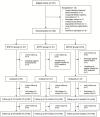The long-term outcomes of preterm infants receiving non-invasive high-frequency oscillatory ventilation
- PMID: 35935354
- PMCID: PMC9353142
- DOI: 10.3389/fped.2022.865057
The long-term outcomes of preterm infants receiving non-invasive high-frequency oscillatory ventilation
Abstract
Objective: To investigate the clinical outcomes of preterm infants who received non-invasive high-frequency oscillatory ventilation following extubation in a neonatal intensive care unit.
Methods: Infants born between 25 and 34 weeks of gestation with a birth weight of <1,500 g, who were admitted into the neonatal intensive care unit of Guangxi Maternal and Child Health Hospital, Nanning, Guangxi, China, requiring mechanical ventilation on admission were randomized to the non-invasive high-frequency ventilation group, nasal intermittent positive pressure ventilation group, or nasal continuous positive airway pressure group following extubation. Their respiratory and neurodevelopmental outcomes were assessed at 12 and 24 months of corrected age.
Results: Among 149 preterm infants who underwent randomization, 139 completed their treatment in the neonatal intensive care unit (45, 47, 47 in the non-invasive high-frequency ventilation group, nasal intermittent positive pressure ventilation group, or nasal continuous positive airway pressure group, respectively), 113 were assessed at 12-month corrected age, and 110 of 113 were assessed again at 24-month corrected age. There were no differences in the number of times bronchitis, pneumonia, wheezing episodes, and re-hospitalization rates appeared due to respiratory diseases among the three groups (P > 0.05); the pulmonary function tests at 12-month corrected age showed respiratory rate, tidal volume, inspiratory time/expiratory time, time to peak expiratory flow/expiratory time, volume at peak expiratory flow/expiratory volume, expiratory flow at 25, 50, and 75% tidal volume were all similar among infants from the 3 groups (P > 0.05). There were no differences in the rates of neurodevelopmental impairment among the three groups at 24-month corrected age (P > 0.05).
Conclusion: As post-extubation respiratory support in preterm infants, non-invasive high-frequency ventilation did not increase the rates of long-term respiratory morbidities and neurodevelopmental impairment compared with nasal intermittent positive pressure ventilation and nasal continuous positive airway pressure.
Keywords: follow-up; non-invasive high-frequency oscillatory ventilation; non-invasive ventilation; outcome; preterm infant.
Copyright © 2022 Li, Mo, Yao, Wei, Meng, Tan and Pan.
Conflict of interest statement
The authors declare that the research was conducted in the absence of any commercial or financial relationships that could be construed as a potential conflict of interest.
Figures
References
-
- Vento G, Pastorino R, Boni L, Cota F, Carnielli V, Cools F, et al. Efficacy of a new technique - INtubate-RECruit-SURfactant-Extubate - “IN-REC-SUR-E” - in preterm neonates with respiratory distress syndrome: Study protocol for a randomized controlled trial. Trials. (2016) 17:1–10. 10.1186/s13063-016-1498-7 - DOI - PMC - PubMed
-
- Greenough A, Lingam I. Invasive and non-invasive ventilation for prematurely born infants - Current practice in neonatal ventilation. Expert Rev Respir Med. (2016) 10:185–92. - PubMed
LinkOut - more resources
Full Text Sources
Research Materials


